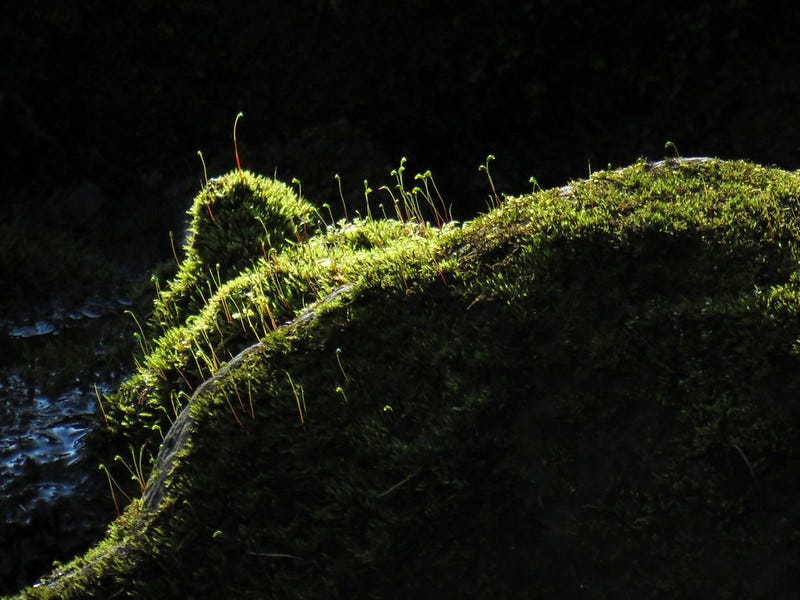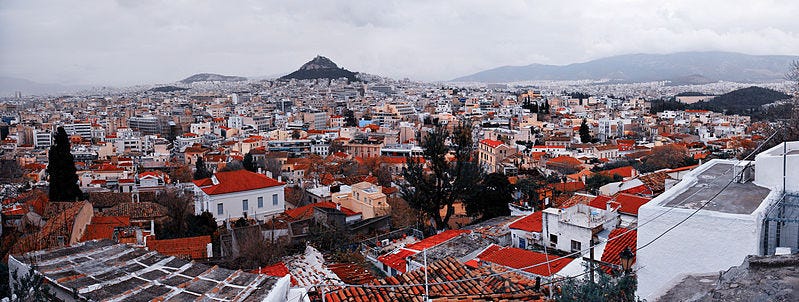26 August 2021. Plants | Heat
If the plants told us their names; Athens appoints a Chief Heat Officer
Welcome to Just Two Things, which I try to publish daily, five days a week. Some links may also appear on my blog from time to time. Links to the main articles are in cross-heads as well as the story.
#1: If the plants told us their names
I missed Robin Wall Kimmerer’s book Braiding Sweetgrass when it was republished last year, but I have had it recommended to me twice in a week, which is usually telling you something. Looking it up, I find that it is regarded as a ‘surprise bestseller’.
Kimmerer is a woman of Native American descent who teaches Environmental Biology at the State University of New York. Her only other book, written two decades ago, was about mosses.
There are reviews here and here.
(Photo: ‘Kingdom of Moss’, by Blue Ridge Kitties/flickr. CC BY-NC-SA 2.0)
The piece I enjoyed most while I was catching up was a long interview with Kimmerer in The Believer from late last year.
It’s a long and rich interview, and I’m not going to do it justice here, but the theme of her book—her work—is about learning from plants, partly at a spiritual level. In this she is influenced by the teachings and practice of the Citizen Potawatomi Nation to which she belongs.
Here’s some of the extracts from the interview that I found striking.
When the pandemic struck, she was talking to her class, who were anxious about the pandemic, about the break-up of their community, and their imminent return to their family homes, and she counselled them to think about they could learn from mosses:
I wanted to give them some kind of comfort. So I said, “Well, what do you think the mosses would say about this time? What do mosses have to teach us about uncertainty?” And one of the things we settled on together was the power of staying home. Because mosses have, as you know, a strong sense of philopatry, that love of home. They live “here” in a very specific niche and not anyplace else (many of them). By staying home, people and mosses are able to engage in reciprocal relationships with place. That place is taking care of you, but in order for that to happen, you have to take care of that place, which mosses do, and which people can do when they are rooted in place.
The second element of the story she tells that struck me—and this is partly because it makes the Western scientific tradition seem strange—is about how naming conventions for animal, plant and insect species have worked since the ‘Scientific Revolution’. We’re all still living with the system of taxonomy that Carl Linnaeus devised, in a ‘Carl gave names to all the animals’ kind of a way:
In Braiding Sweetgrass, I play with that idea, wondering what it would be like if Carl Linnaeus, the “father of Western taxonomy,” met the great namer of our Potawatomi people, Nanabozho, who didn’t just stamp a name of his choice on others. It was said that the names he learned came from getting to know those other beings so well that they told him what their names were. Which is so different from that command-and-control notion of I, Linnaeus, dub you Abies balsamea. That is a kind of ownership, as well as an objectification, and a kind of control for sure. As opposed to recognizing the sovereignty of other beings who already have their own names.
Apparently in the Potawatomi language, which she speaks, and in other indigenous languages, ‘the language is all about acts of being. It isn’t about naming and holding things in place.’ Verbs, not nouns, in other words. (This set me off on a line of thought about whether you needed noun-based languages to have a consumption-based culture, but getting to the bottom of that could be a lifetime’s work).
And when she talks about the word “we”, later in the interview, you realise quite quickly that she isn’t just talking about humans.
We are all earthly beings, human and non-, and all are subject to the same forces of nature. I know that some people might perceive the attempt to dethrone human exceptionalism as a real threat, but to me it’s a kind of wonderful liberation. A liberation into kinship to say, Oh my gosh, there are other intelligences around us. We don’t have to figure all this out for ourselves. There are others who are far better at this than we are, including the mosses. They’ve been around for 350 million years. They’ve seen every climate change, every pandemic, shifting continents, volcanoes, everything that’s happened. They have endured through it. What does it mean to be successful, then, when most species in that length of time have gone extinct?
One of the pleasures of reading the interview was the sense throughout of a very different worldview of the one I was brought up in. And that—even if I understand rationally that it’s not all about humans—I’m still quite a long way away from understanding that viscerally.
The book’s on order; I hope to do a review when I’ve read it.
#2: Athens appoints a Chief Heat Officer
One of the exercises that futurists is to imagine jobs of the future that don’t exist yet. (They maybe like it a bit too much). The theory is that it allows people to imagine, for example, ways in which the future might be different from the past.
So my attention was caught by a tweet from the futurist Adam Gordon that riffed off this trope:


Several of the articles about the appointment are paywalled, but there’s a good interview with Athens’ first Chief Heat Officer, Eleni Myrivili at Euro Cities. (America’s Miami-Dade County appointed a Chief Heat Officer in April). Large scale studies of global warming impacts on cities put Athens—along with other Greek cities—somewhere near the top:
“We’ve been talking about global warming for decades. There’s a lot of discussions about sea level rise but not much about extreme heat. Part of it is because it doesn’t create a big show, it doesn’t really take roofs off buildings. Heatwaves are a weird, silent and invisible monster that is very dangerous to humans,” says Myrivili.
Mortality rates increase by 3% for every one-degree Celsius above 34 degrees, according to the Dianeosis research and policy institute in Greece. The most vulnerable urban residents are also the most vulnerable to heat effects:
“It’s not just those above 65 years of age. It’s also pregnant women, babies and small children who have trouble regulating their body temperatures. It’s all those residents living in informal settlements without any type of insulation against heat, so migrants living in camps or containers, but also anyone living in a crowded apartment without air conditioning as well as workers in menial jobs, both indoors and outdoors.”
(Athens skyline by Mstyslav Chernov, via Wikipedia. CC BY-SA 3.0)
One of the strategies that Myrivili is discussing to make heat more visible as a danger is to start giving them names, as we do for hurricanes:
“Together with meteorologists and climate scientists, we are considering naming heatwaves and categorising them like hurricanes. This will make events more prominent in people’s minds, turning weather phenomena into an entity. People are able to think of an event more clearly if they can call it by a name and media can more easily communicate it to their audiences. Categorising heatwaves will help authorities to set up risk management protocols.”
j2t#156
If you are enjoying Just Two Things, please do send it on to a friend or colleague.




